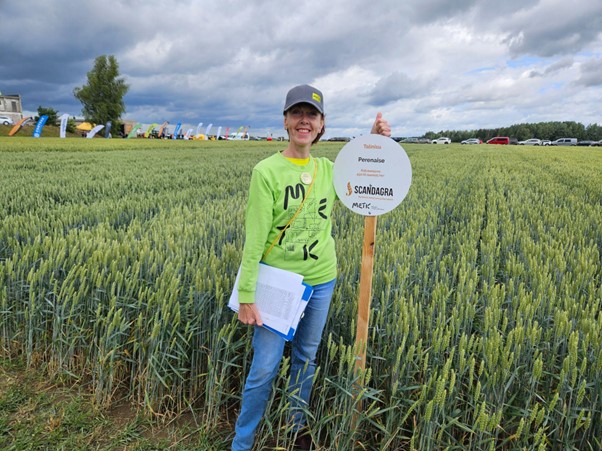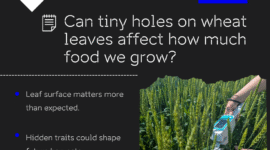The weather is changing our fields and, ultimately, what ends up on our plates. Estonian farmers are racing against climate change.
The taste of coffee will change, and carrots might lose some of their texture and taste, kale could become more bitter. There could be less variety of fresh produce on the shop shelves altogether. This is what we can expect with the changing climate.
For many Estonians, warm black bread plays a central role in their kitchen and cultural identity. What this staple food will taste like for future Estonians we don’t quite know yet. As the weather becomes more unpredictable, other priorities besides the changing taste become apparent. The cereals now have to adapt to the extreme weather and an increasing number of diseases and pests. Scientists are modeling the “perfect” crops for these new conditions, and the taste is not the priority.
Preparing for the heat waves
Known for its thriving agriculture, the golden fields sway in the wind in the Estonian countryside.
Cereals, in general, play an important role in Estonian agriculture. This doesn’t seem to be fading away either. The cereal production per inhabitant has almost doubled since 2018, according to Statistics Estonia. “Estonia’s plant growing sector is excellent,” said Evelin Loit, Associate Professor of Plant Breeding at the Estonian University of Life Sciences. “Our agronomists can adapt quickly and achieve a great deal in relatively poor environmental and weather conditions.”
Agricultural systems in Northern Europe are expected to be further exposed to increased temperatures, especially during winter. More extreme weather events like heatwaves, heavy rainfalls, winter storms and drought are projected to occur.
Traditionally, autumn has been the time to harvest. Planting mostly occurred during the spring, but not anymore. Instead of the spring, farmers now sow more and more in autumn as the winter crops are coming forth. That way, they can take most of the humidity in the soil throughout the winter and early spring. The roots grow long and deep, catching every drop of water they can. This makes them more resistant to the spring droughts, Loit explained.
At the Centre of Estonian Rural Research and Knowledge, a new giant greenhouse is under construction where crop researchers can test the expected drought period on plant growth and other genotypes. The researchers are also using special drones to monitor the crops better. Efficiency matters when dealing with rapid changes.
“The prognoses show us that people will increasingly turn to plant-based food,” Loit explained. “Beans and peas are becoming more important.” This also requires new knowledge in the field. “Ideally, we should be able to grow and eat all the food ourselves in Estonia, an important factor for food security,” Loit said.
What we can say with certainty, Loit said, is that the crops are not going anywhere. The question is, how can we grow them better?
The taste, unfortunately, is pushed to the side. The warming weather brings new thriving diseases and pests that the crops now have to fight with. It spreads weeds, insects, pests and diseases to new areas.
Pathogens are very viable. If plant breeders breed a resistant variety, new races of the pathogen may soon appear to which the variety is no longer resistant, warned Reine Koppel, a senior researcher at the Centre of Estonian Rural Research and Knowledge. It’s a constant race. What matters is that the cereal can survive extreme weather conditions and droughts with “effective nutrition”. “This has led to the situation where the taste characteristics of very common produce are no longer as satisfactory as they used to be,” Loit said.

The hot spot of climate change
Europe is one of the world’s largest and most productive suppliers of food and fiber. It accounted for 17.6 per cent of the global cereal production during 2014–2018, according to a recent EU study published in the European Journal of Agronomy. As the warming climate has increased the frequency, intensity and duration of heat waves over Europe, the warming is greatest at high latitudes in Northern Europe.
According to the EU project EUCP, North-Eastern Europe will become the hot spot of climate change. Estonia’s capital, Tallinn, could resemble Amsterdam or Budapest. Warmer, wetter, and with less snow and ice.
For most of Europe, the growing season will be prolonged by 1.5–2 months in the late 21st century, the study showed.
On a positive note, extended growing seasons in Northern Europe will allow new crops, like sweet potato, proso millet and sorgo, to be grown. Estonian farmers are even testing with soya beans. The planting areas of wheat and oilseed rape have increased consistently over time.
“Our scientists are multifunctional,” said Koppel. “We deal with all these different issues intricately.”
Who knows if the taste of black bread will even matter soon? Perhaps local soya beans and sweet potato and chickpea patties will take over this central place on our tables. It is scary and exciting all at the same time.
Written by: Marian Männi. This article was funded by the European Regional Development Fund through Estonian Research Council.
 Back
Back



